(This article was originally posted as a build log here in late 2021: https://hackaday.io/project/182946/logs)
THE GHOST OF CHRISTMAS PAST....
My brother Ricky is HARD on video players and media. Really hard. Since
we were kids he'd watch one spot of a tape until it snapped and broke in
the VCR. I grew up figuring out how to splice and extract busted tapes,
reset VCRs, and intuited not to touch the big red wire inside his
TV/VCRs well before I had anyone who could tell me the angry pixies were
hiding under that suction cup.
The VHS era was great for folks
of limited mobility or cognitive ability. Stuff chunky plastic tape into
hole, watch video. Simple. DVDs made the care and feeding of video
media much more difficult for folks who can't understand or aren't able
to avoid scratching, smudging, or otherwise being rough on DVDs and DVD
players.
In 2013 I built Ricky a small "arcade cabinet" with a
modified 5-disc DVD changer inside wired to arcade game buttons for
controls, and this served him well for several years, but nothing lasts
forever, DVD's heyday came and went, and an unfortunate incident with
chocolate milk spilling between the cracks ended the DVD player's
tenure.
Ever since my family should have purchased stock in
various DVDs he's been fond of. Lilo and Stitch, Knight Rider (with the
'hoff of course), and others. I've also worked with hackerspace friends
to roll up various Raspberry Pi based video player solutions for Ricky,
some of which even lasted a year or two under his heavy use.
I didn't get to see him all of last year, and this year for Christmas I'm bringing him a new player.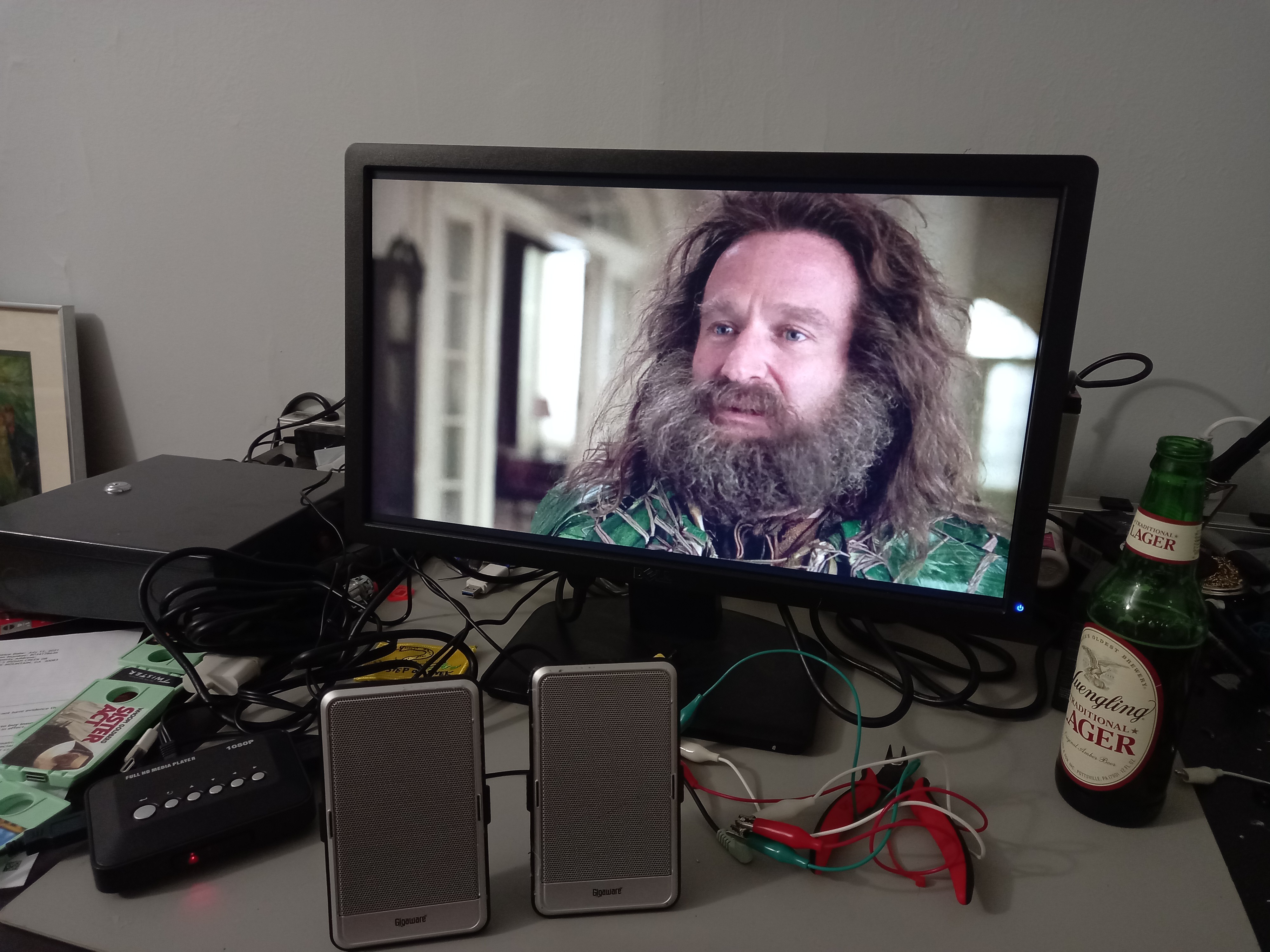
BACK TO BASICS
One serious hurdle to making Ricky a solid video player is his ability
to understand it's usage grammar. I'm not sure if this is the correct
term in engineering design, but it seems correct to me. If there are
menus he might get lost, if button presses don't quickly yield some
change he gets frustrated or confused. Sometimes the same goes for his
caregivers, be they family or helpful nursing staff. You can't blame
someone who's confused at how to make a one-off prototype machine behave
if it doesn't do what they expect other similar machines to do.
To
that end I've tried to make simple, flat, simple interfaces in previous
players, but sometimes prototyped machines do strange things when I've
already driven home several hours away and that's a sad time for
everyone. This time around I'm essentially outsourcing the video player
design to an inexpensive no-name USB/SD card video player.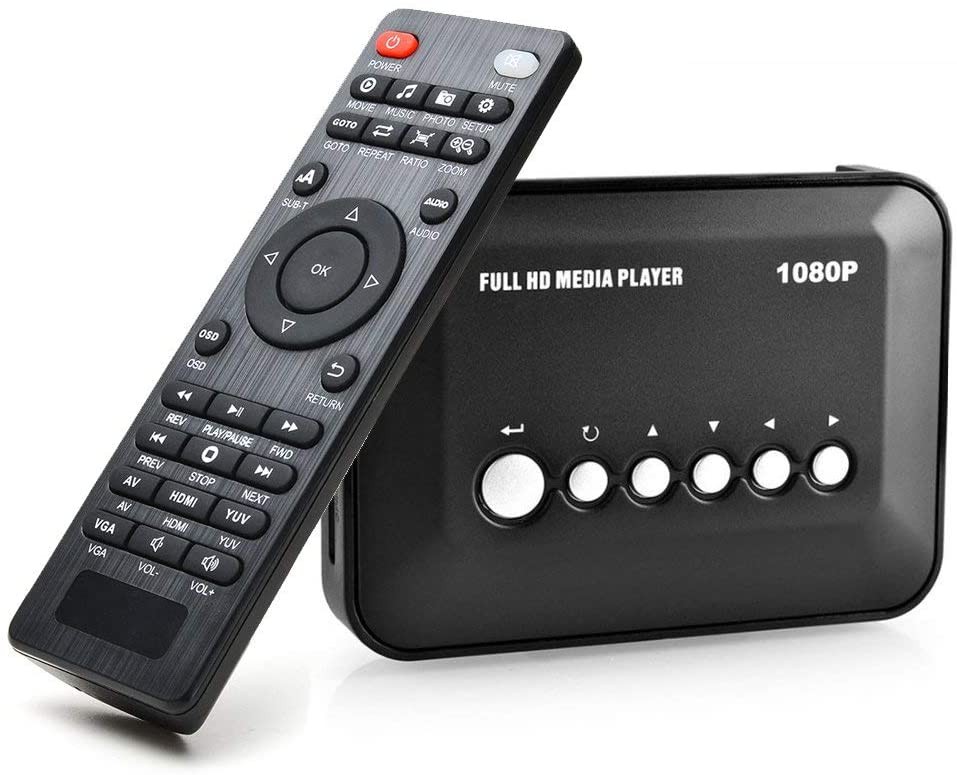
With some setting fiddling this player seems to be great for what I
need. Autoplays anything plugged into it, outputs video to HDMI and
audio to RCA plugs without a fuss. Only trick is some of the most needed
buttons only live on the remote. Well balls....
It's not the end of the world that the controller is the only way to get
at the fast forward and rewind buttons. I'm a fairly dab hand with an
iron, so I gutted the controller, charted out what pins on the control
chip do what, stuck it on perfboard with some Wago-style spring
terminals to make running out to other buttons easy, and got out some
small wire and the 60/40.
With a little testing I've now got easy access to run the most important
buttons remotely without worrying about tearing the gossamer thin
traces from this cheapie single-sided remote control board. Also I added
connections to run it from a 3vdc wall wart so batteries in the remote
aren't of concern.
Don't forget the intrinsic documentation. The next poor asshole working on it will thank you, and it's likely to be you anyway....
BUILDING THE CABINET
With all the main parts ordered or on-hand, tested, and everything
working on the test-bench, it's time to make something that can take a
licking and keep on playing, and that starts with the cabinet. I've
decided to plagiarize TV design from the late 80s to the mid 90s and
just make a simple boxy thick box. a PC monitor will mount in the front, the electronics will be mounted to the sides or bottom of the
cabinet, and the whole thing will be constructed of half-inch ply with a
removable back for servicing.
WHAT KIND OF "TAPES" ARE THOSE?
The format wars have not been kind to special needs folks. With added
complexity, features, more compact shapes, and the like comes fragility,
more difficulty in understanding, and frustration if things don't
behave the same every time you try to use it. The VCR blinking 12:00 was
innocuous enough, but how do you explain to a toddler they can't watch
their favorite show because their disc is scratched, they're in the
wrong menu, and besides that, the TV was set to the wrong input?
Well the first thing you can do is make the physical media harder to
damage or use incorrectly. Over the years I've tried hiding the media in
a cabinet, keeping it in the SD card or USB stick attached to a Pi, but
you know? VHS tapes were pretty robust, what's a similar take for the
modern era?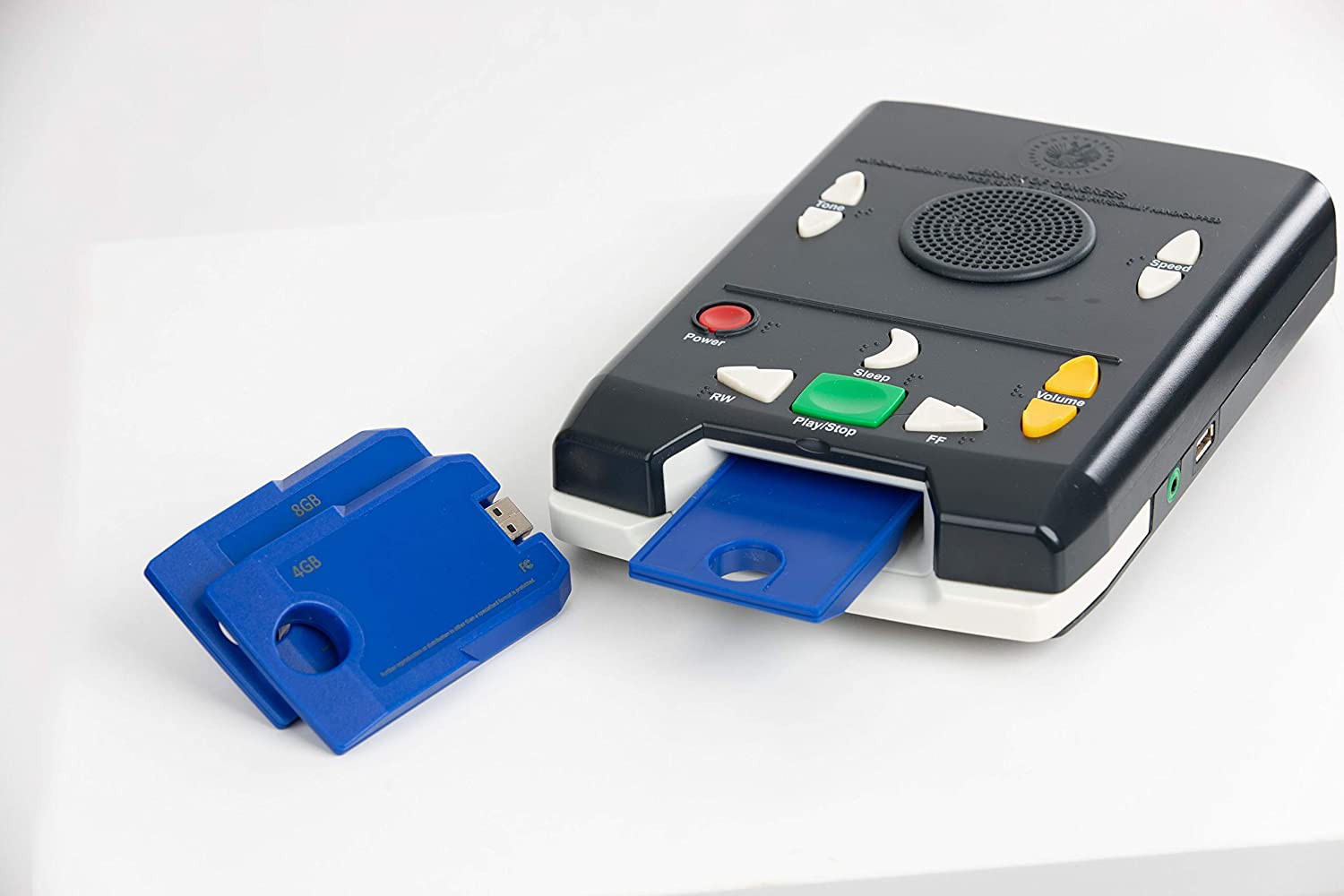
While doing my day job I noticed this audio player in the homes of some
visually impaired older folks. Turns out the library of congress makes
these audiobook players for folks with poor sight, and these cartridges
that are basically USB sticks in a chunky case that only goes into the
player one way.
A couple of years ago I made a video player by
modifying one of these and using the cartridge port, but the raspberry
pi software I'd used didn't get much time to test before covid, and
unfortunately the player got cranky after I left . *sigh*
SCREWS AND GLUE
Decided to forego the corner pieces of the cabinet to leave a little
more wiggle room since after edge-screwing the cabinet together it was
plenty sturdy. With a bit of superglue around all the seams to help hold
it all rigid, I was left with a box with a hole in it.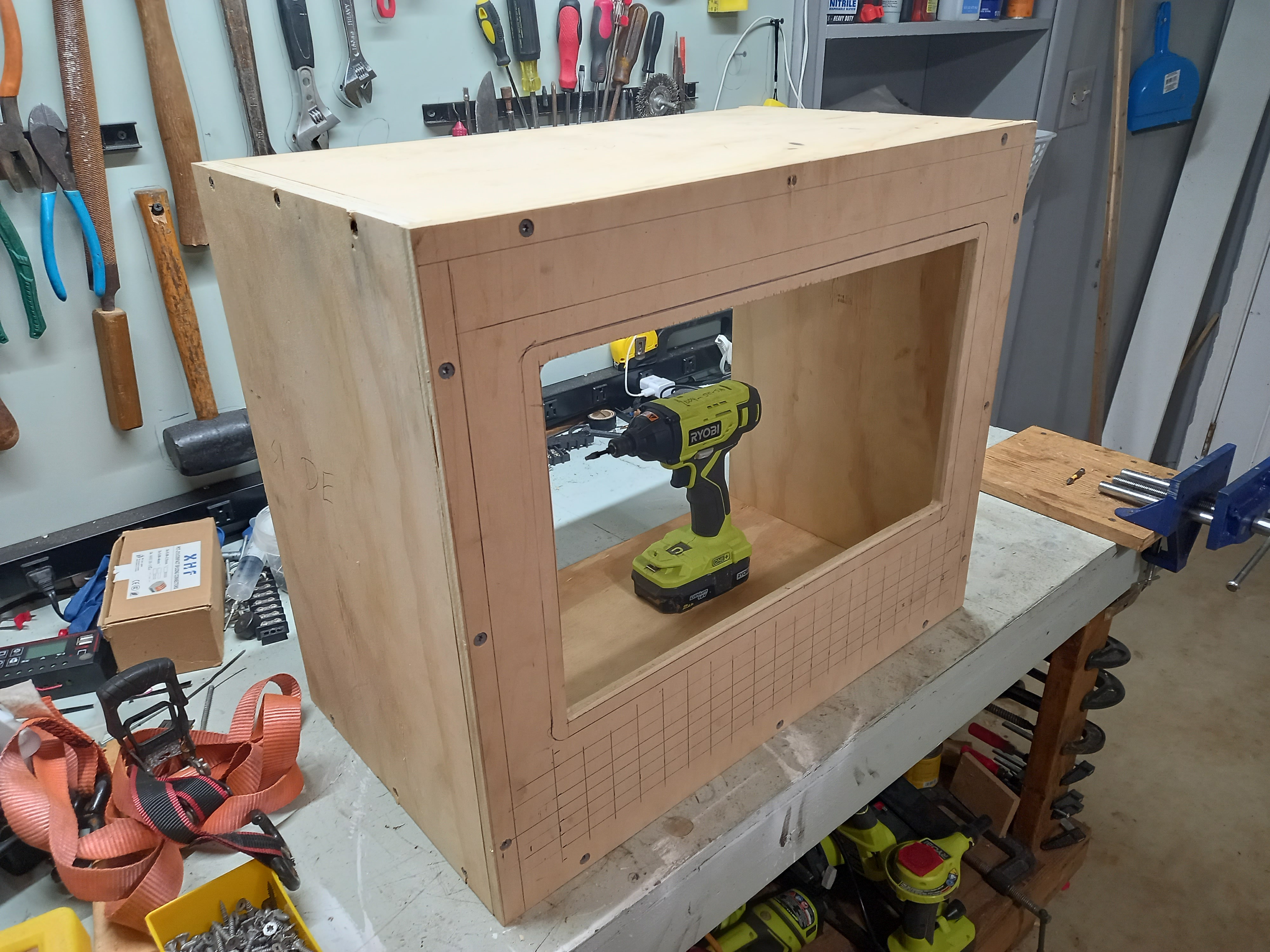
From there I realized I'd left most of the guts meant to go into it
except the screen at my hackerspace (shoutout Freeside Atlanta!), so
rather than my usual methodology of "smash all the parts in and make it
go BRRRR" I took a more metered approach and filled holes and rough
spots, sanded it smooth, and then installed the screen since I at least
had that with me at home.
Sometimes I'm a clever duck. As I was trying to decide how to best mount
the electronics to the inside of the case it occured to me I can just
screw a board to the screen's VESA mount and stick most of the guts of
the player to that, so I did. 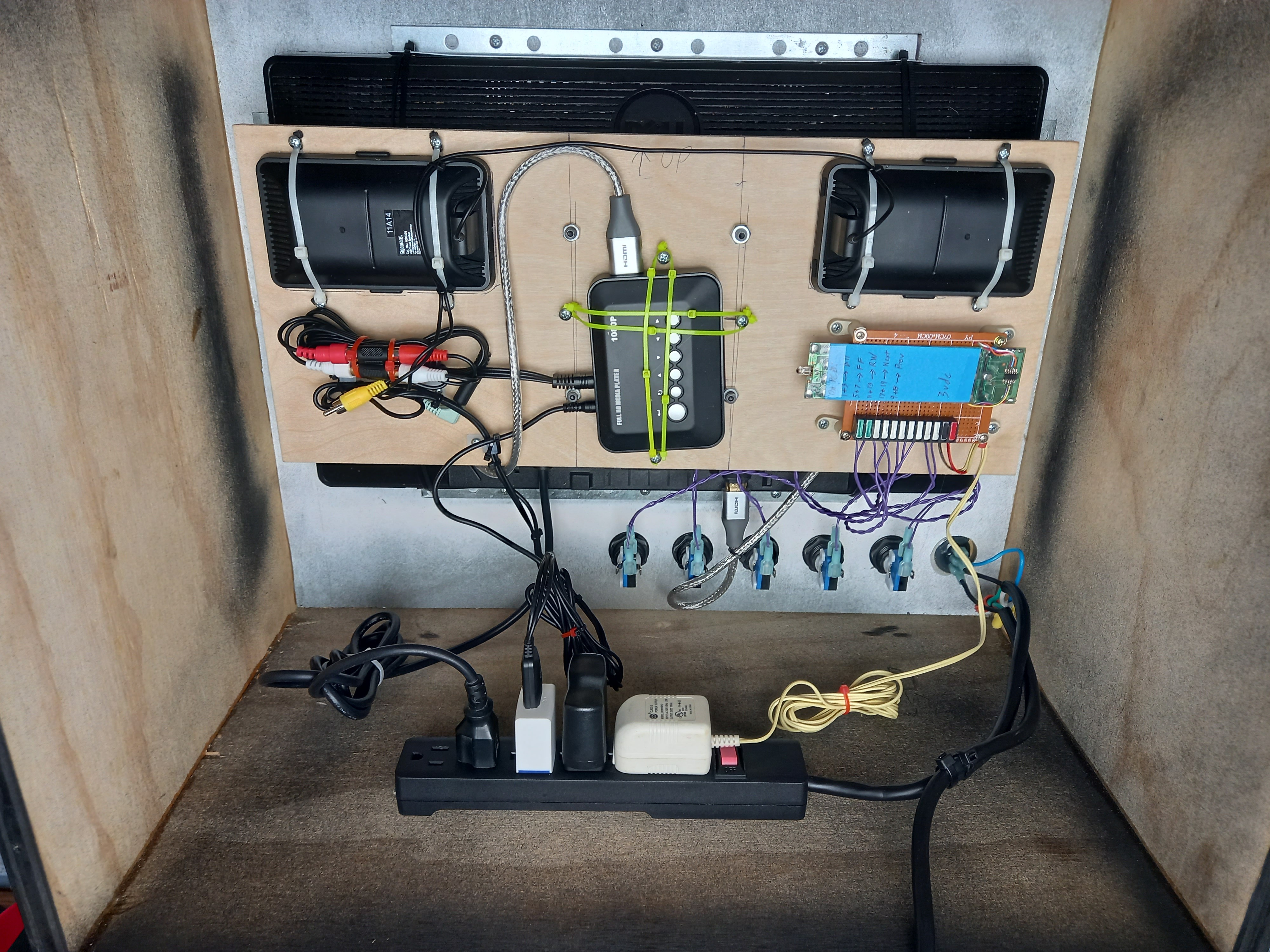
The punch list is getting shorter now. As you can see I've added label
inserts to the button faces. I've also taken the liberty of making a
clear acrylic screen cover I'll attach soon, it could use some vent
holes and a fan for the backside to keep the screen from slow-roasting
itself, and then there's just that cartridge port that need to hurry
itself up and get here before I need to head down for my visit....

(The USB cartridge slot ganked from a talkingbook player. Is it a karmic injustice to make a media player for disabled folks from a media player for disabled folks? If so I'll be in for another round of samsara I guess)
So it plays great, looks pretty good, and I've written a decent essay on
it. What next? Well if the past is anything to go on I can expect a
phone call in a week or month or year asking for help to get it going.
I've built it as well as I can in the few weeks of free time I've had to
make it, and given this is the..... 7th? iteration of custom video
player I've built him maybe this one will last longer than the other s
have? Only one way to find out!
(UPDATE For 2024: The player has been working without any help from me but bringing Ricky fresh video carts when they get lost. A new record for his media players of any stripe going back all the way to VHS tapes!)




No comments:
Post a Comment